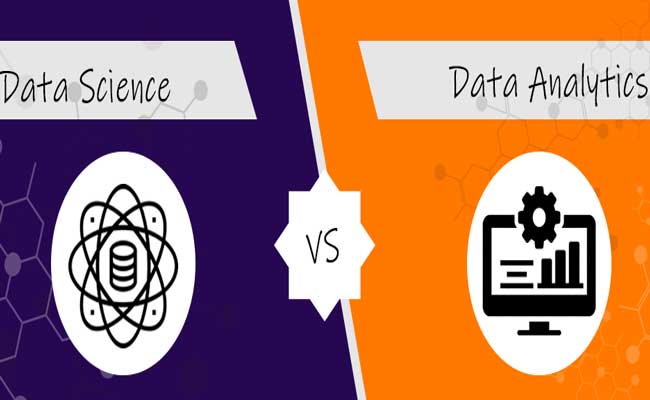Data Science vs Data Analytics: What Is The Difference? 2023 While a career in technology may naturally inspire you to pursue a degree in engineering or computer science, in today’s world of predictive marketing, cloud computing, and global thinking, data-related jobs are in high demand.

A job in data science vs data analytics can be the appropriate fit for you if you have a natural curiosity and enjoy learning new things. The question is how the two fields differ and where they might connect.
Data Science vs Data Analytics: What Is The Difference?
What Is Data Science?
Data Science is the process of combining, preparing, and analyzing huge datasets using tools, processes, and techniques like programming, statistics, machine learning, and algorithms. The data in the datasets is often a mixture of organized and unstructured data.
The purpose of data science is frequently to detect patterns and develop actionable insights, but it can also be to generate broad insights by asking questions, determining the best questions to ask, and selecting areas to investigate.
What Is Data Analytics?
While the mathematical and logical thinking abilities required for success as a data scientist are similarly useful for a job as a data analyst, there are some key differences.
The text and Brian Letort Letort, Brian A data analyst mines current data to interpret it and deliver findings depending on their organization’s specific business objectives, whereas a data scientist focuses on how to best get and use data. A data analyst will examine data, attempt to comprehend and analyze it, and then communicate the results to stakeholders in a meaningful and accessible manner.
Visual and graphic design talents, as well as good interpersonal and communication skills, are frequently required. Letort said, “A data analyst is a storyteller.” “When you examine the data, you consider how to visually convey it to other stakeholders as a narrative, taking into account the graphics you might employ to make the data accessible to them.”
Because you must know and comprehend your customer’s needs, the profession necessitates a high level of business intelligence and interpersonal skills.
What Is The Key Difference Between Data Science Vs Data Analytics?
Although both Data Science and Data Analytics are based on statistics, their roles and backgrounds are vastly different. Some important distinctions between a data scientist and a data analyst are listed below.
- The first major distinction between a Data Scientist and a Data Analyst is that a Data Scientist finds problems before fixing them, whereas a Data Analyst solves them. Companies engage data analysts to help them address their business difficulties. A data analyst’s job is to look for trends in sales or to use summary statistics to describe consumer interactions. A data scientist, on the other hand, not only fixes issues but also prevents them from occurring in the first place.
- Communication and business knowledge are not required of data analysts. Data analysts are constrained by the limitations of data analysis. They are not required to share the results with the team or to assist them in making data-driven decisions. However, in order to transform discoveries into commercial plans, a data scientist must have good story-telling and managerial skills. As a result, a data scientist participates actively in the company’s decision-making process.
- Another significant distinction between a data scientist and a data analyst is how they handle data. SQL queries are used by data analysts to retrieve and handle structured data. Data Scientists, on the other hand, use NoSQL for unstructured data. As a result, data scientists are in charge of both unstructured and structured data.
- Data scientists are responsible for fine-tuning data models and improving data products. It also necessitates the optimization of data-driven goods and machine-learning models. Data analysts do not require this. As a result, a data scientist’s job includes not just creating models but also tuning and maintaining them.
Data Scientist vs Data Analyst – Responsibilities
A Data Scientist’s Main Responsibilities Include:
- Both data transformation and data cleansing are required. The data must also be pre-processed by a Data Scientist.
- Machine learning is being used to forecast and classify patterns.
- Predictive models are optimized and tuned accordingly.
- Analyzing the company’s requirements and developing questions to help solve them.
- Creating dynamic visuals for the team’s communication results.
The Following Are Some Of A Data Analyst’s Main Responsibilities:
- Statistical techniques are used to do data analysis and interpretation.
- Data extraction and storage in databases.
- Cleaning and filtering data is a task that needs to be completed.
- Exploratory data analysis is being used to visualize data.
- Assisting teams in analyzing business requirements.
Roles Of Data Scientist And Data Analyst In Terms Of Skill Sets
Data scientists’ roles based on their skill sets —
- Data Scientists
- Data Science Managers
- Big Data Architects
- Data Engineers
- Decision Scientists
Roles for Data Analysts based on their skill sets —
- Database Administrators
- Data Analysts
- Statisticians
Conclusion
Data science and data analytics have a lot in common, but they also have some significant distinctions. I hope you found this summary of significant distinctions helpful, whether you desire to be a data scientist or a data analyst. If you already play one of these two roles, I hope you learned something new, and if you have any questions or thoughts, please leave a message in the comments section below.